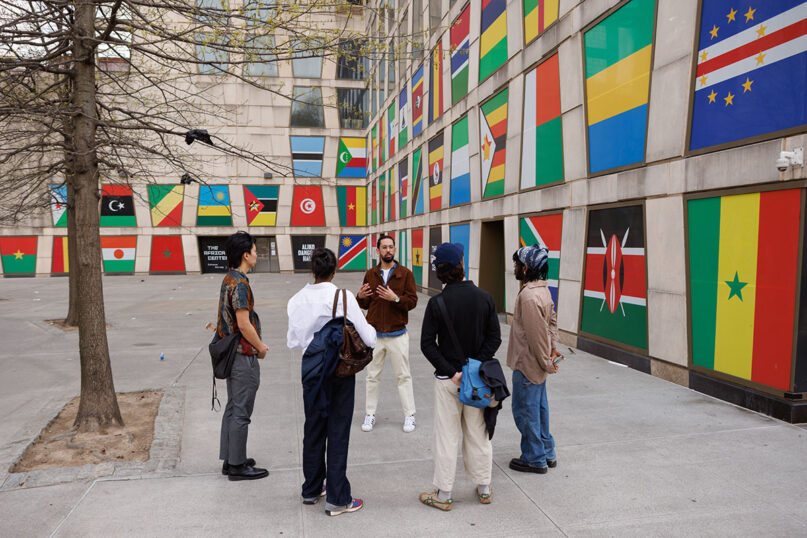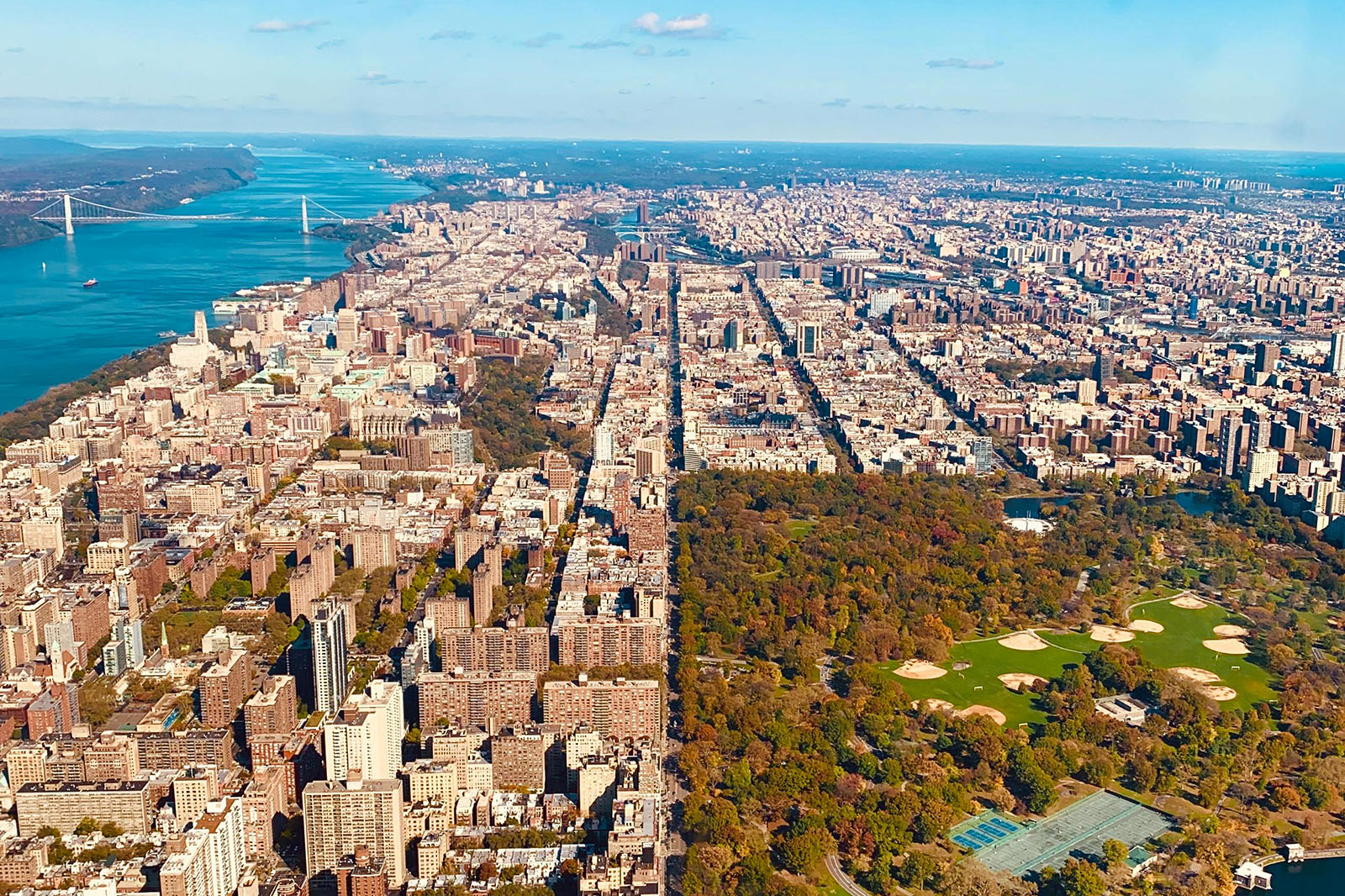A museum educator for the Museum of the City of New York with a background in Islamic studies, Dandia draws from both his professional interests and personal experience as a Pakistani American who grew up in southern Brooklyn. He shows a side of New York many aren’t familiar with, referring to it as “my New York.”
RELATED: Once marginalized, New York’s Muslims celebrate growing political influence on Muslim Day
“I try to demonstrate how Muslims are deeply interconnected and intertwined with the histories of New York City,” Dandia said in an interview before the tour.

Asad Dandia, center, leads a New York Narratives walking tour outside The Africa Center in Harlem, April 19, 2025, in New York. (Photo © Syed Yaqeen for American Muslim Experience)
On the company’s flagship Muslim Harlem tour, Dandia covers five different communities that settled in the neighborhood, highlighting American Muslims’ diversity.
The group first stopped at the Islamic Cultural Center on the Upper East Side, the city’s first mosque built for that purpose, as earlier mosques were created in homes or apartments. In Spanish Harlem, Dandia touched on the history of Hispanic Muslims and Bengali immigrants. After a stop at a Somali restaurant — the only one in the city, Dandia said — for chicken suqaar and bits of East African history, the group headed to central Harlem. In Little Senegal, Dandia delved into the history of West African immigrants and their kinship with Harlem’s African American residents. The tour, which ended early on that April day, usually ends in front of Masjid Malcolm Shabazz in central Harlem, where Malcolm X once preached.
The itinerary covers various Muslim sects, from the Nation of Islam to Sufism. It places a “great emphasis on Islam in Harlem as a lived religion,” according to the New York Narratives website.

Asad Dandia leads a New York Narratives walking tour, April 19, 2025, in New York. (RNS photo/Fiona André)
He came up with the idea of creating tours focused on New York’s religious minorities after noticing few walking tours reflecting the city’s immigrant communities, where Dandia grew up. Since he launched the company, Dandia has broadened tour offerings to cover Ottoman Empire diplomats who settled on Manhattan’s Lower West Side and highlight Harlem’s cultural relevance for Black Muslims.
“There was a tremendous gap in how public historians and tour guides talk about New York City’s communities,” he said. “I just saw that some stories were not being told that I felt needed to be told.”
Through his tours, Dandia hopes to demystify the history of Muslim New York by highlighting the community’s contributions to the city. Muslim presence in New York, he said, dates back 400 years and has added to the “city’s tapestry and its culture.”
“Muslims are a central part of New York,” he said. “We are your doctors, your pharmacists, we are your cab drivers. We’re making your halal food right at the food carts, and we’re involved in social justice movements. We’re educators.”
When developing a new tour, he relies on historians, history books, local faith leaders, activists, and community historians as integral sources, he said.
“They share with me their knowledge and what they know, and I turn it into a compelling story with their consent and with their support,” he said, adding he also pulls from old newspapers and other written archives to craft his itineraries.
Since 2023, he has taken hundreds of university students and professors on tours, as well as nonprofit staff, eager to learn more about the communities they serve.
The opportunity to talk about Muslim New Yorkers’ experiences without focusing on Islamophobia feels refreshing, he said.
“I can talk about cultural traditions, theologies, urban religion, and all of that really fun stuff,” he said.
In 2013, Dandia was among plaintiffs who filed a lawsuit against the New York Police Department for its decade-long surveillance of Muslims. The suit resulted in a change in the NYPD’s policies, barring it from opening investigations on the basis of race, religion, or ethnicity.
Dandia also helped curate the “City of Faith” exhibition at the Museum of the City of New York in 2022, which documented religious profiling that South Asian Americans faced post-9/11.
Still, on the tours, Dandia often addresses how Muslim New Yorkers navigate anti-Muslim biases and the impact the post-9/11 Islamophobia peak had on the community.
Recently, he started developing a tour in conjunction with the Tenement Museum, which covers immigration in New York from the late 19th century to the 1970s, to explore Muslim history on the Lower East Side and Buddhist and Taoist communities in the area.
“Asad’s outlook on history and working with community members and sort of unearthing untold stories felt so aligned with the way the Tenement Museum shares stories of immigrant and migrant communities,” said Kathryn Lloyd, vice president of programs and interpretations at the museum.
Their joint tour, still in the planning phase, is part of the museum’s “Lived Religion” project, which looks at religious practices of Lower East Side communities. The project, funded by a Lilly Endowment grant, will help the museum document the experience of Muslim immigrants, Lloyd said. Though the museum currently documents the lives of a German Jewish immigrant family, an African American family, and families from Puerto Rico, China, and Italy, the museum had no section on a Muslim family.
“They’re a community that often doesn’t get talked about as much, so we’re excited to kind of elevate both the past and present Muslim communities on the Lower East Side,” Lloyd said.
Religion News Service receives funding from Lilly Endowment.



